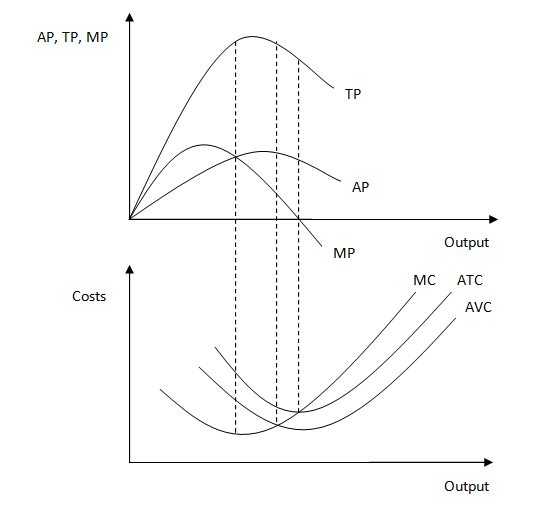Introduction;
The theory of the firm is concerned with how the production process is organized such as the scale or size of units. In discussing scale or size must distinguish between firm’s plant and industries.
A PLANT
Refers to the physical establishment of capital used in production and nglish-swahili/distribution” target=”_blank”>distribution of goods and services.
OR
Is the smallest business productive unit owned by the firm.
It refers to the production units devoted to creation of particular goods and services such unit will have a distinct output or range of output in the form of goods and services.
A FIRM
Is any productive business unit with its own or more management and control eg KTM, MUTEX, IPP MEDIA in Tanzania.
AN INDUSTRY
Is the sum of all firms that produce similar line of products but being differentiated interms of color, labels, grades e.g. textile industry, building industry and cement manufacturing industry in Tanzania.
OBJECTIVE OF A FIRM
The primary objective of any business firm is to maximize profit, other objectives may be;-
- Maximize output.
- Maximize sales and total revenue.
- Employment creation.
- Cost minimization.
edu.uptymez.com
LOCATION OF THE FIRM
Refers to the establishment of the firm to an area or place irrespective whether other firms exist or do not.
FACTORS CONSIDERED IN ESTABLISHING A FIRM
Producers usually consider many factors before establishing a firm so as to produce at less quality earns much revenue and maximize profit. These factors include;
-
Raw materials.
The producer would prefer to establish a firm where there are raw materials. That is the case when raw materials are bulky or perishable which are difficult to transport.
-
Market
The firm is located near the market especially when final products are bulky or perishable E.g. furniture making, milking process etc.
-
Power
It attracts industries especially when power is difficult to transport or when it is bulky.e.g steel industries.
-
Transport
Most firms are built near transport routes Eg roads or harbors to make easy transportation of goods from factories to the market.
-
Water
This is when water is used as an input eg production of hydro-electricity, beer.
-
External economies of scale
Most firms are located where others already exist so as to share the same facilities enjoy external economies of scale.
-
Government policies
The government can establish or ennglish-swahili/courage” target=”_blank”>courage the establishment of a firm in an area to create employment or as a policy to balance development.
LOCATION OF THE FIRM
edu.uptymez.com
Refers to the concentration of firms in one area.
OR
The establishment of firms in a place where other firms already exist because or proximity to raw materials, power, market etc.
ADVANTAGES OF LOCATION OF THE FIRM
- It ennglish-swahili/courage” target=”_blank”>courages the establishment of other related business enterprises in one area ie Bank, insurance agent etc.
- Helps to employ more skilled and experienced staffs.
- Outputs of some firms may be used as inputs of other firms.
- Increases production and reduces the transport cost.
- Easy to get loans from financial institutions because it is easy to be trusted.
- Enable the workers from one firm to share skills and experience to the workers of the other firms.
edu.uptymez.com
DISADVANTAGES OF LOCALIZATION OF THE FIRM
- It may result into congestion of population in one area or town hence difficult to provide all necessary needs ie Housing, education, health Center etc.
- It may lead to the underdevelopment of some parts of the country because people migrate from one part to another where there are few firms on another part, where there is more firms on industries to secure employment.
- It is not desirable to have many firms in one area only especially when an event occurs eg calamities.
-
This can lead to unemployment of large number of workers especially when the industry or firms are forced to close.
CONCEPT OF COSTS
edu.uptymez.com
- Cost refers to the expenses incurred by the firm to secure factors of production. Cost of production affects the supply in the two ways;
edu.uptymez.com
- It determines the quality to the produce by the particular firm.
- It determines the number of firms in the production of a particular commodity.
edu.uptymez.com
VARIOUS CONCEPTS OF COST
Refers to the exception of all different kinds of cost that are directly or indirectly involved in making it together with obstinacy or rather the waiting required to saving the capital used in making it.
- It includes;
edu.uptymez.com
- Exertion of all kind of labor.
- Waiting and sacrifice required for saving capital.
edu.uptymez.com
NOTE
It is more psychological concept to and cannot be measured thus it is not applied in actual price.
PRIVATE AND SOCIAL COSTS
PRIVATE COSTS
Refers to all expenses incurred by a person or producer in producing of commodities E.g. for a factory i.e. private cost is the expenses on raw material, power electricity wages, and transport.
SOCIAL COSTS
Refers to the cost which falls on the society during the course of producing commodity.
Thus in social cost we include not only the cost to the firm or producer but also costs by the society in order to produce that commodities.
Social cost includes washing bills for others. Medical bills and pollution due to smokes that emits from the chimneys of the factory, road maintenance, road accidents etc.
MONEY COST
Refers to the monetary expresses incurred by the firm in producing a commodity. It is measured interms of money, sometimes it is known as PRODUCTION COSTS .This total money include
- Implicit cost.
-
Explicit cost.
IMPLICIT COST
edu.uptymez.com
Refers to the implicit cost of the factors of production owned by the producer himself which are left out in the collection of the expenses of the firm.
They are called implicit costs because producers do not make payments to others for them. Eg rent of his own land interested on his own capital and salary for his own services as a manager.
EXPLICIT COST
Refers to the actual payment made by the firm for purchasing or hiring resources or factor services e.g. labor, wages, capital (interest), land (rent) and payment of raw material.
NOTE
The difference between implicit cost and explicit cost is that in explicit cost payment is made to others while in implicit cost payment is not made to others.
OPPORTUNITY COSTS /ALTERNATIVE COSTS
Is the amount of other goods which have to be given up in order to produce one additional unit of commodity i.e. the cost of forgone alternative. E.g. if with given resources wheat worth’s Tsh 500 or alternatively rice worth is Tsh 400 can be produced on the plot of land.
We can say that opportunity cost of wheat is the rice which worth Tsh 400.
COST FUNCTION
Refers to the functional relationship between cost and quality produced.
I.e. C = f (QX)
Where,
C = cost function.
QX= Quantity produced of x goods.
- The cost function of a firm depends on two things;
edu.uptymez.com
- Production function.
- Price of the factors of production.
edu.uptymez.com
PRODUCTION FUNCTION
Tells in that the amount of output depends on the quality of the factors of production i.e output of the firm the high would be its production cost.
TOTAL COST
Refers to the total expenses incurred by the firm in the production process.
TC = TFC + TVC
Where
TC = Total cost
TFC= total fixed cost
TVC = total variable cost
TOTAL VARIABLE COST (TVC)
Refers to the expenses incurred on the variable factors of the production on the cost that vary directly with the output e.g. expenses on raw materials, power and fuels, wages of daily labours etc.
- It is sometimes known as PRIME COST.
edu.uptymez.com
FIXED VARIABLE COSTS / SUPPLEMENTARY COSTS / OVER HEAD COSTS
Fixed costs are the expenses incurred on the fixed factors on production i.e. they do not vary with the output. E.g. rent, interest, insurance, premium, salaries of permanent employs etc.
A GRAPH OF TFC CURVE
- TFC curve is a horizontal curve parallel to the x – axis which tells us that total fixed cost remains the same at all levels of output.
edu.uptymez.com
TOTAL VARIABLE COST
Refers to the cost which very directly with the output i.e. rising as more is produced and falling as left is produced. They are also called prime cost or special cost or direct cost or avoidable costs of wages of temporary labors, raw material, fuel, electric power etc.
TVC = QX factors cost.
|
Q |
TVC |
|
0 |
0 |
|
1 |
18 |
|
2 |
30 |
|
3 |
40 |
|
4 |
52 |
|
5 |
65 |
|
6 |
82 |
|
7 |
100 |
|
8 |
140 |
edu.uptymez.com
GRAPH
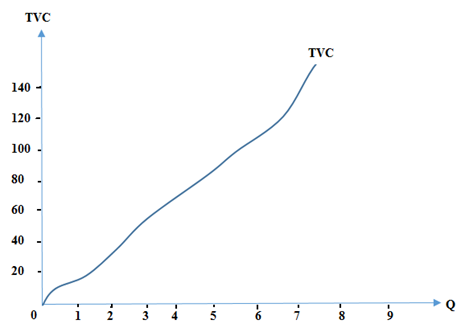
From the above graph and table TVC increases directly with the value of output
TOTAL COST
Total cost means the total cost of producing any given amount of output. It is obtained from the addition of total fixed cost and total variable cost.
I.e. TC = TFC + TVC
NOTE
TC is a function of total product and varies directly with it.
I.e. TC = f (Q)
Thus the total cost curve is obtained by adding TFC and TVC curved vertically at each point.
Relationship between TFC, TVC and TC
|
Output |
TFC |
TVC |
TC |
|
0 |
20 |
0 |
20 |
|
1 |
20 |
18 |
38 |
|
2 |
20 |
30 |
50 |
|
3 |
20 |
40 |
60 |
|
4 |
20 |
52 |
72 |
|
5 |
20 |
65 |
85 |
|
6 |
20 |
82 |
102 |
|
7 |
20 |
100 |
120 |
|
8 |
20 |
140 |
160 |
edu.uptymez.com
GRAPH
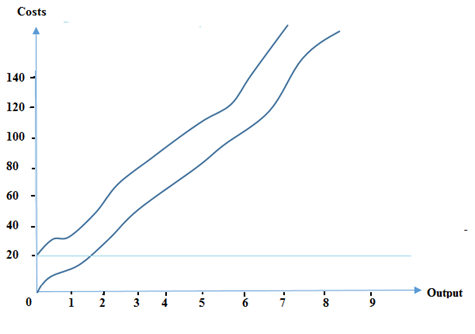
From the graph and table make the following:-
-
Assuming there is no implicit cost
TC = TFC + TVC therefore TC –TVC. The gap between TC and TVC represents TFC and therefore is constant.
-
When output is zero there is no variable cost in current.
TVC = 0 so TC = TFC
- As output increases TVC and TC increases also. TC increases by the same amount as TVC because TVC are fixed at all level of output i.e. TC = TVC + TFC. TFC is constant therefore increase in TC is due to increase in TVC.
edu.uptymez.com
VARIATION OF COSTS IN THE SHORT RUN
It is in the short run we have fixed cost in the long run all costs short run we have fixed cost in the long run all costs are variable to analyze the relationship between costs and output we use average and marginal costs instead of using totals.
Therefore cost can be described as;
- Average total cost (AC )
- Average fixed cost ( AFC )
- Average variable (AVC )
- Marginal cost ( MC )
edu.uptymez.com
Average Total cost ( ATC )
Refers to the total of producing per unit output.
i.e. . AC = TC/Q Where,
Q = output
TC = Total cost
AC in the short is illustrated on the graph by short run average cost SAC.
GRAPH
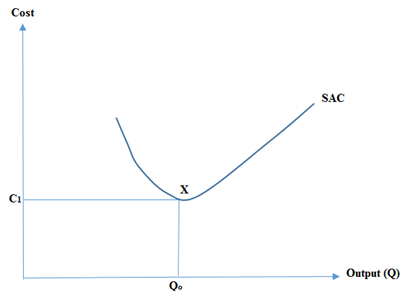
The short run average cost is U –shaped be because of the law of diminishing returns short run cost first falls because of specialization and increased utilization of the fixed factors. At the point x have minimum costs (optimum point)optimum point reached when the firm produces high output OQ2 at lowest OC1 at that point there is effective utilization of fixed point.
- After point x the cost per cost unit output increase because of over utilization of fixed factor which results into ( diminishing )
edu.uptymez.com
- .AC = TC/Q therefore when output increases because of increasing returns AC falls, when output is maximum and have minimum AC (at optimum) when output is falling because of diminishing returns AC would be increasing.
-
When input is producing output less than optimum, OQo when it is working under excess capacity.
(AFC) Average fixed cost
edu.uptymez.com
Refers to the fixed costs incurred in producing such unit of output.
I.e. AFC = TFC/Q
Since fixed cost is constant it means that as output increase after decrease.
Average variable cost (AVC)
Refers to the variable costs incurred in producing each unit of output.
i.e. Average = TVC/Q
Where Q is total output
Marginal cost (MC)
This refers that addition cost incurred in producing an extra unit of output.
MC = ∆TC/∆Q
∆TC means change in total cost.
∆Q means change in output.
The relationship between ATC, AVC, MC and AFC are illustrated by the curve below;-
GRAPH OF CURVE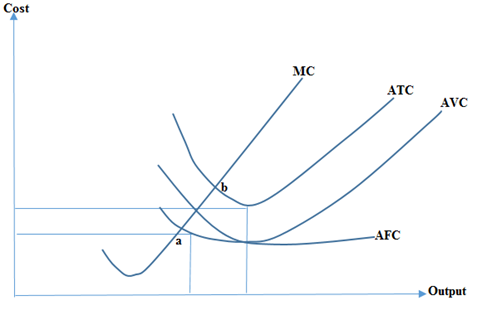
The graph shows the variation of cost ATC, AVC, AFC and MC.
- The following should be noted
edu.uptymez.com
- ATC curve, AVC curve and MC curve are U-shaped because of the law of diminishing returns.
- As the level of output increases, the ATC curve comes close to the AVC because of consistent fall in AFC which is a component of ATC.
- AVC curve is below the ATC curve because ATC = AVC + AFC the difference between the ATC and AVC is AFC.
- MC lines below the ATC where AFC is falling and above the ATC where the ATC is rising.
- MC lies below the AVC when AVC is falling and above when AVC is rising.
-
The MC meets the AVC and ATC at their lowest points.
VARIABLE OF COSTS IN THE LONG RUN
edu.uptymez.com
There is no fixed cost in the long run. The time is too long such that the firm is able to vary all the factors of production and therefore all costs become variable.
To increase output, the firm expands in size. The firm expands developing in whether the firm is enjoying advantages of expansion (economies of scale) or disadvantages of expansion (dis economies of scale).
Long run – AC refers to the summation of short run average cost.
GRAPH FOR ILLUSTRATION
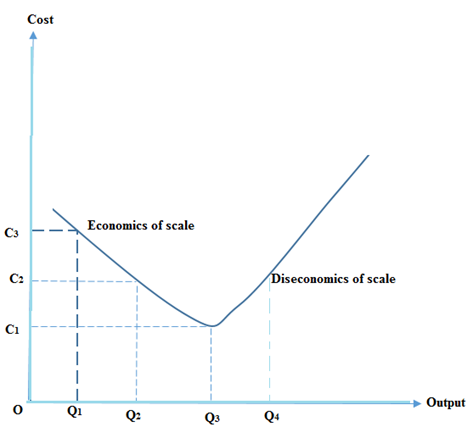
From the figure is the optimum size of the firm in long run therefore the long run Average cost curve ( LAC ) is U- shaped because of economies of scale while in the short run average cost curve ( SRAC ) is U – shaped because of law of diminishing returns.
RELATIONSHIP BETWEEN MP, AP AND ATC, MC AND AVC CURVE
- Average total cost and total product curve.
- Average variable and average product curve.
- Marginal cost and marginal product curves.
edu.uptymez.com
RELATIONSHIP BETWEEN MARGINAL PRODUCT CURVE AND MARGINAL COST CURVE
-When the marginal product is increasing, marginal cost is decreasing
-When marginal product curve is at maximum, marginal cost is at minimum
